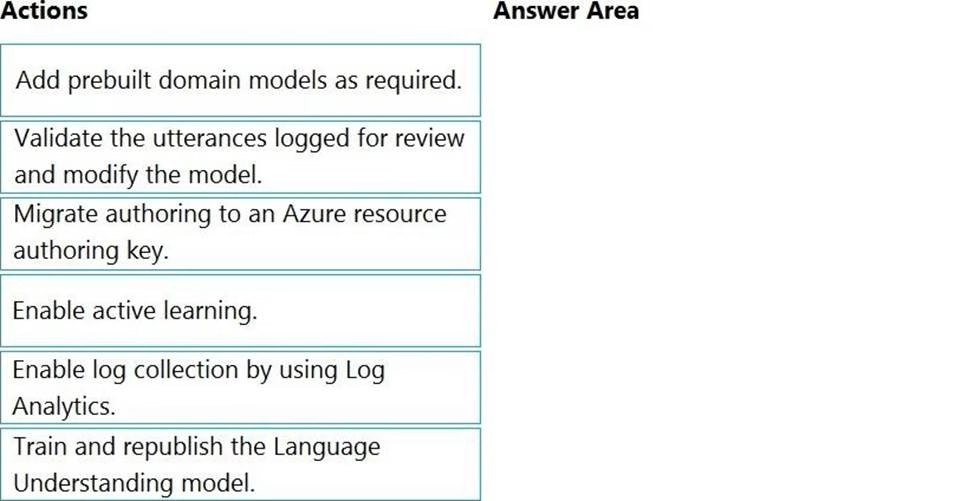Microsoft AI-102 Designing and Implementing a Microsoft Azure AI Solution Online Training
Microsoft AI-102 Online Training
The questions for AI-102 were last updated at Dec 09,2025.
- Exam Code: AI-102
- Exam Name: Designing and Implementing a Microsoft Azure AI Solution
- Certification Provider: Microsoft
- Latest update: Dec 09,2025
DRAG DROP
You plan to build a chatbot to support task tracking.
You create a Language Understanding service named lu1.
You need to build a Language Understanding model to integrate into the chatbot. The solution must minimize development time to build the model.
Which four actions should you perform in sequence? To answer, move the appropriate actions from the list of actions to the answer area and arrange them in the correct order. (Choose four.)

DRAG DROP
You plan to build a chatbot to support task tracking.
You create a Language Understanding service named lu1.
You need to build a Language Understanding model to integrate into the chatbot. The solution must minimize development time to build the model.
Which four actions should you perform in sequence? To answer, move the appropriate actions from the list of actions to the answer area and arrange them in the correct order. (Choose four.)

DRAG DROP
You plan to build a chatbot to support task tracking.
You create a Language Understanding service named lu1.
You need to build a Language Understanding model to integrate into the chatbot. The solution must minimize development time to build the model.
Which four actions should you perform in sequence? To answer, move the appropriate actions from the list of actions to the answer area and arrange them in the correct order. (Choose four.)

You are building a bot on a local computer by using the Microsoft Bot Framework. The bot will use an existing Language Understanding model.
You need to translate the Language Understanding model locally by using the Bot Framework CLI.
What should you do first?
- A . From the Language Understanding portal, clone the model.
- B . Export the model as an .lu file.
- C . Create a new Speech service.
- D . Create a new Language Understanding service.
DRAG DROP
You are using a Language Understanding service to handle natural language input from the users of a web-based customer agent.
The users report that the agent frequently responds with the following generic response: "Sorry, I don’t understand that."
You need to improve the ability of the agent to respond to requests.
Which three actions should you perform in sequence? To answer, move the appropriate actions from the list of actions to the answer area and arrange them in the correct order. (Choose three.)

You build a conversational bot named bot1.
You need to configure the bot to use a QnA Maker application.
From the Azure Portal, where can you find the information required by bot1 to connect to the QnA Maker application?
- A . Access control (IAM)
- B . Properties
- C . Keys and Endpoint
- D . Identity
You build a conversational bot named bot1.
You need to configure the bot to use a QnA Maker application.
From the Azure Portal, where can you find the information required by bot1 to connect to the QnA Maker application?
- A . Access control (IAM)
- B . Properties
- C . Keys and Endpoint
- D . Identity
You build a conversational bot named bot1.
You need to configure the bot to use a QnA Maker application.
From the Azure Portal, where can you find the information required by bot1 to connect to the QnA Maker application?
- A . Access control (IAM)
- B . Properties
- C . Keys and Endpoint
- D . Identity
You build a conversational bot named bot1.
You need to configure the bot to use a QnA Maker application.
From the Azure Portal, where can you find the information required by bot1 to connect to the QnA Maker application?
- A . Access control (IAM)
- B . Properties
- C . Keys and Endpoint
- D . Identity
You build a conversational bot named bot1.
You need to configure the bot to use a QnA Maker application.
From the Azure Portal, where can you find the information required by bot1 to connect to the QnA Maker application?
- A . Access control (IAM)
- B . Properties
- C . Keys and Endpoint
- D . Identity
Latest AI-102 Dumps Valid Version with 80 Q&As
Latest And Valid Q&A | Instant Download | Once Fail, Full Refund



